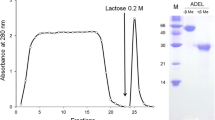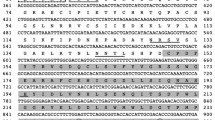Abstract
A divalent cation-independent 16 kDa d-galactose binding lectin (AKL-2) was isolated from eggs of sea hare, Aplysia kurodai. The lectin recognized d-galactose and d-galacturonic acid and had a 32 kDa dimer consisting of two disulfide-bonded 16 kDa subunits. Eighteen N-terminus amino acids were identified by Edman degradation, having unique primary structure. Lectin blotting analysis with horseradish peroxidase-conjugated lectins has shown that AKL-2 was a glycoprotein with complex type oligosaccharides with N-acetyl d-glucosamine and mannose at non-reducing terminal. Two protein bands with 38 and 36 kDa in the crude extract of sea hare eggs after purification of the lectin was isolated by AKL-2-conjugated Sepharose column and elution with 0.1 M lactose containing buffer. It suggested that the lectin binds with an endogenous ligand in the eggs. AKL-2 kept extreme stability on haemagglutination activity if it was treated at pH 3 and 70 °C for 1 h. Glycan binding profile of AKL-2 by frontal affinity chromatography technology using 15 pyridylamine labeled oligosaccharides has been appeared that the lectin uniquely recognized globotriose (Galα1-4Galβ1-4Glc; Gb3) in addition to bi-antennary complex type N-linked oligosaccharides with N-acetyllactosamine. Surface plasmon resonance analysis of AKL-2 against a neo-glycoprotein, Gb3-human serum albumin showed the k ass and k diss values are 2.4 × 103 M−1 s−1 and 3.8 × 10−3 s−1, respectively. AKL-2 appeared cytotoxicity against both Burkitt’s lymphoma Raji cell and erythroleukemia K562. The activity to Raji by the lectin was preferably cancelled by the co-presence of melibiose mimicing Gb3. On the other hand, K562 was cancelled effectively by lactose than melibiose. It elucidated that AKL-2 had cytotoxic ability mediated glycans structure to cultured cells.









Similar content being viewed by others
Abbreviations
- AKL:
-
Sea hare (Aplysia kurodai) eggs lectin
- ASF:
-
Asialofetuin
- BSM:
-
Bovine submaxillary mucin
- ConA:
-
Concanavalin A
- FACT:
-
Frontal affinity chromatography technology
- Gb3:
-
Globotriose (Galα1-4Galβ1-4Glc)
- GPC:
-
Gel permeation chromatography
- PA:
-
Pyridylamine
- PSM:
-
Porcine stomach mucin
- PVDF:
-
Polyvinyllidene difluoride
- SPR:
-
Surface plasmon resonance
- WGA:
-
Wheat germ agglutinin
- WST-8:
-
2-(2-methoxy-4-nitrophenyl)-3-(4-nitrophenyl)-5-(2,4-disulfophhenyl)-2H-tetrazolium, monosodium salt
References
Altschul SF, Madden TL, Schaffer AA, Zhang J, Zhang Z, Miller W, Lipman DJ (1997) Nucleic Acids Res 25:3389–3402
Caldwell GS, Pagett HE (2010) Mar Biotechnol 12:241–252
Fujii Y, Kawsar SMA, Matsumoto R, Yasumitsu H, Ishizaki N, Dogasaki C, Hosono M, Nitta K, Hamako J, Taei M, Ozeki Y (2011) Comp Biochem Physiol B Biochem Mol Biol 158:30–37
Gilboa-Garber N, Susswein AJ, Mizrahi L, Avichezer D (1985) FEBS Lett 181:267–270
Gilboa-Garber N, Sudakevitz D (2001) FEMS Immunol Med Microbiol 30:235–240
Hewick RM, Hunkapiller MW, Hood LE, Dreyer WJ (1981) J Biol Chem 256:7990–7997
Hirabayashi J, Arata Y, Kasai K (2003) Methods Enzymol 362:353–368
Hirabayashi J, Hashidate T, Arata Y, Nishi N, Nakamura T, Hirashima M, Urashima T, Oka T, Futai M, Müller WEG, Yagi F, Kasai K (2002) Biochem Biophys Acta 1572:232–254
Johnson PM, Kicklighter CE, Schmidt M, Kamio M, Yang H, Elikin D, Michel WC, Tai PC, Derby CD (2006) J Exp Biol 209:77–78
Kamiya H, Sakai R, Jimbo M (2006) Prog Mol Subcell Biol 43:215–239
Kamiya H, Shimizu Y (1981) Bull Jpn Soc Sci Fish 47:255–259
Kawano T, Sugawara S, Hosono M, Tatsuta T, Ogawa Y, Fujimura T, Taka H, Murayama K, Nitta K (2009) Biol Pharm Bull 32:345–353
Kawsar SMA, Matsumoto R, Fujii Y, Yasumitsu H, Dogasaki C, Hosono M, Nitta K, Hamako J, Matsui T, Kojima N, Ozeki Y (2009) Biochemistry (Moscow) 74:709–716
Kawsar SMA, Takeuchi T, Kasai K, Fujii Y, Matsumoto R, Yasumitsu H, Ozeki Y (2009) Comp Biochem Physiol B Biochem Mol Biol 152:382–389
Kawsar SMA, Fujii Y, Matsumoto R, Yasumitsu H, Uchiyama H, Hosono M, Nitta K, Hamako J, Matsui T, Kojima N, Ozeki Y (2009) Protein Pept Lett 16:677–684
Kawsar SMA, Fujii Y, Matsumoto R, Ichikawa T, Tateno H, Hirabayashi J, Yasumitsu H, Dogasaki C, Hosono M, Nitta K, Hamako J, Matsui T, Ozeki Y (2008) Comp Biochem Physiol B Biochem Mol Biol 150:349–357
Kicklighter CE, Shabani S, Johnson PM, Derby CD (2005) Curr Biol 15:549–554
Kyhse-Andersen J (1984) J Biochem Biophys Methods 10:20–209
Laemmli UK (1970) Nature 227:680–685
Matsui T (1984) Biol Bull 166:178–188
Naganuma T, Ogawa T, Hirabayashi J, Kasai K, Kamiya H, Muramoto K (2006) Mol Div 10:607–618
Nakamura S, Yahi F, Totani K, Ito Y, Hirabayashi J (2005) FEBS J 272:2784–2799
Nitta K, Ozaki K, Ishikawa M, Furusawa S, Hosono M, Kawauchi H, Sasaki K, Takayanagi Y, Tsuiki S, Hakomori S-I (1994) Cancer Res 54:920–927
Ozeki Y, Matsui T, Yamamoto Y, Funahashi M, Hamako J, Titani K (1995) Glycobiology 5:255–261
Ozeki Y, Matsui T, Suzuki M, Titani K (1991) Biochemistry 30:2391–2394
Shinohara Y, Kim F, Shimizu M, Goto M, Tosu M, Hasegawa Y (1994) Eur J Biochem 223:189–194
Smith PK, Krohn RI, Hermanson GT, Mallia AK, Gartner FH, Provenzano MD, Fujimoto EK, Goeke NM, Olson BJ, Klenk DC (1985) Anal Biochem 150:76–85
Sugawara S, Kawano T, Omoto T, Hosono M, Tatsuta T, Nitta K (2009) Biochim Biophys Acta 790:101–109
Takakura D, Norizuki M, Ishikawa F, Samata T (2008) Mar Biotechnol 10:290–296
Tateno H (2011) Biosci Biotechnol Biochem 74:1141–1144
Wiechelman KJ, Braun RD, Fitzpatrick JD (1998) Anal Biochem 75:231–237
Wilson MP, Carrow GM, Levitan IB (1992) J Neurobiol 23:739–750
Wu AM, Song SC, Chen YY, Gilboa-Garber N (2000) J Biol Chem 275:14017–14027
Yamazaki M, Kisugi J, Ikenami M, Kamiya H, Mizuno D (1984) Gann 75:269–274
Zipris D, Gilboa-Garber N (1987) Dev Comp Immunol 11:501–511
Acknowledgments
This work was supported in part by a Grant-In-Aid for scientific research (No. 1021009100 and 22580226) from the Japan Society for the Promotion of Science (JSPS), Japanese Association for Marine Biology (JAMBIO, Project No.23-04) from Ministry of Education, Culture, Sports, Science and Technology (MEXT) Japan and Strategic Research Project (No. G2307) from Yokohama City University (YCU).
Author information
Authors and Affiliations
Corresponding author
Additional information
Sarkar M. A. Kawsar and Ryo Matsumoto is equal contribution as the first author.
Rights and permissions
About this article
Cite this article
Kawsar, S.M.A., Matsumoto, R., Fujii, Y. et al. Cytotoxicity and Glycan-Binding Profile of a d-Galactose-Binding Lectin from the Eggs of a Japanese Sea Hare (Aplysia kurodai). Protein J 30, 509–519 (2011). https://doi.org/10.1007/s10930-011-9356-7
Published:
Issue Date:
DOI: https://doi.org/10.1007/s10930-011-9356-7




